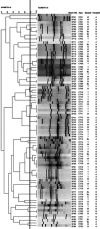Association of the genes encoding Metallo-β-Lactamase with the presence of integrons among multidrug-resistant clinical isolates of Acinetobacter baumannii
- PMID: 31190906
- PMCID: PMC6526166
- DOI: 10.2147/IDR.S196575
Association of the genes encoding Metallo-β-Lactamase with the presence of integrons among multidrug-resistant clinical isolates of Acinetobacter baumannii
Abstract
Background: Metallo-β-Lactamases (MBL) are usually encoded on the gene cassettes harboring integrons and disseminated easily among Acinetobacter baumannii isolates. This study was aimed to investigate the association of the genes encoding MBL with the presence of class 1 and 2 integrons among multidrug-resistant (MDR) A.baumannii isolates. Methodology: A total of 85 non-duplicated A.baumannii isolates were collected and evaluated for the amplification of blaOXA-51. The presence of genes encoding MBLs, including blaIMP, blaVIM, blaSIM, blaSPM, blaGIM, blaDIM and blaNDM , as well as intI 1 and intI 2 was evaluated by PCR. Also, the production of MBLs was screened phenotypically by the combination of EDTA and meropenem. Results: In this study, 77 out of 85 isolates were MDR. Also, 34 isolates had only intI 1, 10 had only intI 2 and 15 had both intI 1 and intI 2. The phenotypic detection of MBLs was found in 30 isolates, among which blaVIM was as the most common the gene encoding MBL followed by blaIMP, blaSPM and blaSIM . The gene cassettes analysis revealed that class 1 integron is often responsible for transferring the genes harboring MBLs. Conclusion: The production of MBLs among A. baumannii strains is one of the main mechanisms of resistance to carbapenems. Therefore, the development of inexpensive screening methods for the phenotypic detection of MBLs in clinical laboratories settings is essential. Also, our data revealed that the class 1 integron is often responsible for the dissemination of the MBL genes among A. baumannii isolates.
Keywords: Metallo-Beta-Lactamase; acinetobacter baumannii; blaIMP; blaVIM; integron.
Conflict of interest statement
The authors report no conflicts of interest in this work.
Figures
References
LinkOut - more resources
Full Text Sources
Miscellaneous


